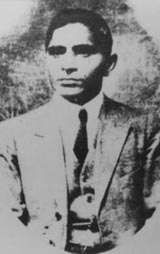Pandurang Sadashiv Khankhoje
| Pandurang Sadashiv Khankhoje | |
|---|---|
 P S Khankhoje | |
| Born |
7 November 1883 Wardha, Maharashtra |
| Died |
22 January 1967 Nagpur, Maharashtra |
| Organization | Ghadar Party, Berlin Committee, Communist Party of India |
| Movement | Hindu-German Conspiracy, Indian Communism |
Pandurang Sadashiv Khankhoje (7 November 1884 – 22 January 1967) was an Indian revolutionary, scholar, agricultural scientist and historian who was among the founding fathers of the Ghadar Party.
Khankhoje was born in November 1884 to a Marathi family at Wardha, where his father worked as a petition-writer. Young Khankhoje spent his childhood in Wardha, where he completed his primary and middle school education before moving to Nagpur for higher education. He was at the time inspired by the nationalist work of Bal Gangadhar Tilak. At some time in the first decade of the 1900s, Khankhoje left India on a voyage that ultimately saw him settle in the United States. Here he enrolled in the Washington State College (now called Washington State University), graduating in 1913. His earliest nationalist work abroad dates back to the time around 1908 when he, along with Pandit Kanshi Ram founded the Indian Independence League in Portland, Oregon. His works also brought him close to other Indian nationalists in United States at the time, including Taraknath Das. In the years preceding World War I, Khankhoje was one of the founding members of the Pacific coast Hindustan association, and subsequently founded the Ghadar Party. He was at the time one of the most influential members of the party. He met Lala Har Dayal in 1911. He also enrolled at one point in a West Coast military academy.
Through World War I, Khankhoje was intricately involved in the Hindu-German Conspiracy when he was involved in the plans for the mutiny. He visited Europe during the war and subsequently went to Mesopotamia along with other members of what was the Berlin Committee. In the summer of 1915, he worked clandestinely among roops of the Indian expeditionary force, spreading nationalist literature and hoping to incite a mutiny. Through the course of the war, Khankhoje made his way through Turkey and Persia under different Muslim guises as far as Baluchistan, spreading Ghadarite propaganda en route. He is known to have attempted insurrections and raised at the Iran-Baluchistan border while Mahendra Pratap's Indo-German expedition attempted to rally the Afghan Emir Habibullah Khan against British India. Towards the end of the war, Khankhoje, like most of the members of the Berlin committee, began turing towards communism. He is known to have been in Soviet Union in company of the earliest Indian communist, including Virendranath Chattopadhyaya, M. P. T. Acharya, M. N. Roy, Abdur Rab Barq. He met Lenin at Moscow in 1921. For his nationalist work at the time, Khankoje was banned from returning to India as a highly dangerous individual.
Khankhoje later moved to Mexico in the 1920s, where he was instated the professor of Botany and Crop Breeding in the National School of Agriculture in Mexico. In 1936, Khankhoje married Jean Alexandrine Sindic, a Belgian women in Mexico by whom he had two daughters. He led the Mexican corn breeding program and was appointed director to the Mexican Government's department of Agriculture. Both Pandurang and Jean returned to India after 1947. His application for visa was initially rejected by the Indian government due to the ban by the British Indian Government, but was eventually overturned. He settled in Nagpur and subsequently embarked on a political career. Pandurang Khankhoje died on 22 January 1967.
References
- Asian American Studies: A Reader. By Jean Yu-wen Shen Wu, Min Song. p40.
- The White Woman's Other Burden: Western Women and South Asia.Kumari Jayawardena. p226
- India-Mexico : Similarities and Encounters. Eva Alexandra Uchmany.
- Encyclopaedia of Political Parties. O.P. Radhan. p259.
- Har Dayal, Hindu Revolutionary and Rationalist. Emily Clara Brown. p 136
- Dictionary of national biography.Sibapada Sen. p333
- Freedom to Breathe: The Revolutionaries' Legacy to India.Tribhuvan Nath.p69.
- The Soviets and the Indian Revolutionary Movement, 1917-1929. Ashok Kumar Patnaik- Page 89
- Bulletin of the Hindusthan Association, No. 1 August 1913, p16
External links
- A Gallery on Gadar Party
- Pandurang Khankhoje materials in the South Asian American Digital Archive (SAADA)
